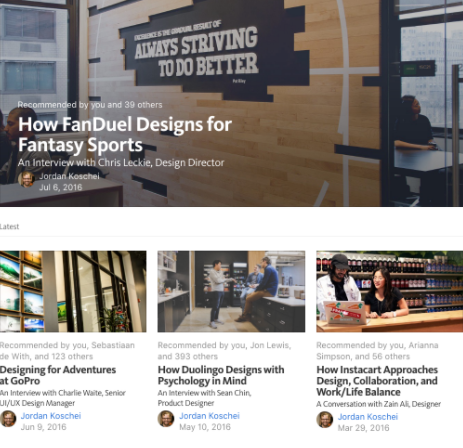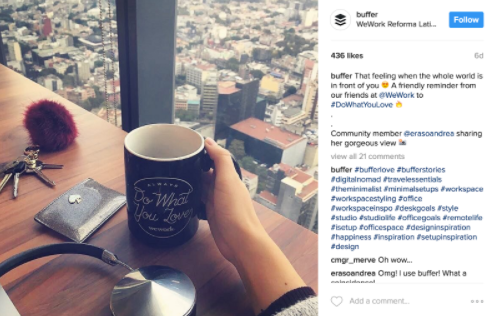When marketers think about user-generated content (UGC), their minds often go to Instagram posts highlighting how much people love Starbucks or photos of real customers wearing a brand’s clothing. Whether it’s to provide context around a particular product or to building awareness around a brand’s mission, consumer focused companies have customer content on lockdown.
However, this type of content isn’t as popular when you enter the B2B space. There’s an element of emotional buying that is disconnected from the typical B2B purchasing experience. And for many brands, user-generated content can come off as tacky or scripted. For example, imagine if you were a security software company and you ran Instagram campaigns asking people to post photos of themselves using your product – a little awkward right? There’s a complete disconnect if you don’t approach the strategy with your audience in mind.
This doesn’t mean that B2B companies are excluded from leveraging user-generated content to fuel their overall growth strategy. Regardless of what they’re buying, customers like to see people using similar products as they are. In particular, Millennials (36% of today’s workforce), are almost just as likely to trust the recommendation of user-generated content as they are recommendations from friends and family. As buyers become more comfortable with review sites and connecting with like-minded individuals through the products they buy, showcasing those new customers will be increasingly important.
Leveraging user-generated content also allows you to save time on content creation while publishing stories that are unique, value driven, and more authentic as these are words from your users. Although you may not have as much creative space to leverage UGC as consumer brands do, here are a few things you can implement:
Create a publication highlighting your customers.

A snapshot of Wake’s “In Progress” Blog
Put your journalist hat on and uncover the interesting lives behind your users. Launch a series where you highlight different customers and create an opportunity to connect them to the rest of your community and potential new customers. See them beyond their professional roles.
Wake, a design collaboration tool for teams, launched a Medium blog called “In Progress”. The series highlights cool things designers are doing in their roles at various companies like GoPro, Instacart, Duolingo and more. Although Wake is mentioned briefly in some of the articles, the majority of the stories are just about the designer and his or her environment.
Capturing a story that emcompasses the lives of your customers is essential to creating a richer community around your brand. As acclaimed marketing expert Simon Sinek said, “the goal is to business with people who believe what you believe.” Creating a story beyond your product allows people to see what it is you believe and how big of a community you have alongside you.
Turn your customers into subject-matter experts.

A subject-matter expert (SME) is someone who has domain authority in a particular area. It’s a common role B2B marketers often try to fill themselves, or they attempt to find someone else’s knowledge and prestige they can leverage. Publishing content by subject-matter experts is a great way to build credibility not only in the industry, but also with new customers. However, finding an available SME can be difficult and expensive. With resource constraints, B2B companies often encourage employees to serve as experts, but they often have other responsibilities.
What if you were able to turn this opportunity to your customers? In any given industry, there is always someone looking for a new path to grow their career. Depending on your space, it may be mutually beneficial to welcome them as a guest writer for your team. You can start out by testing a few people and scaling from there. Search through your database of users and search their names on LinkedIn, Twitter, and other relevant social sites. See if they are already publishing content regarding your industry or are a part of relevant professional groups. Find opportunities to incentivize them through exposure and opportunity to grow their expertise.
Invite customers to show their space.

It can be tough to get customers engaged on a level that inspires social sharing and creativity, especially for B2B businesses. Revisit your overarching company mission and brand and see if there is an opportunity to leverage a hashtag campaign centered around your customer’s environment. Although they might likely be using your service on the computer or in a warehouse, get them to share relatable, authentic content with a unique branded hashtag.
Buffer, the ultimate social media scheduling app, has done a great job at capturing the desk spaces and work areas of its users. The social savvy company has come up with the hashtag #DoWhatYouLove and encouraged Buffer users to share what inspires them in their workspace. It gives Buffer endless content to produce on their Instagram, and makes its users feel great about participating in the community.
Don’t be afraid to take creative risks with video!
According to YouTube, mobile video consumption increases by 100% every year. It may seem irrelevant to B2B content marketers, but it may be the secret to capturing the market. You target audience is dynamic. They have lives outside of the office and certainly have other interests besides reading blog posts and whitepapers. They’re scrolling their Facebook feed, they’re reading forums, and they’re watching videos. As video consumption becomes more of the norm, it’s important all marketers take the leap and create unique videos that elevate their brand message.
Zendesk, the customer service app, has long been known for its clever marketing. A couple years ago, they launched a video of an old couple ranting about their relationship and dropping hilarious innuendos. However, the underlying message was that Zendesk solved their problems and created a better connection between the two. It’s funny, unique, and certainly stands out from its competitors.
Videos are not only entertaining, their effective for conversions. According to a recent report by Vidyard and Demand Metric, a video on a landing page can increase conversion by 80%. In the same report, 63% of B2B marketers said they will be increasing their spend on video production. If your team hasn’t embraced the trend, it’s time you hit play on your video gameplan or else you may be left behind.
Just because you’re a B2B marketer, doesn’t mean you can’t break out of the mold and try something new on for size. Explore how consumer brands are leverage UGC and see how you can apply this to your next marketing campaign.




